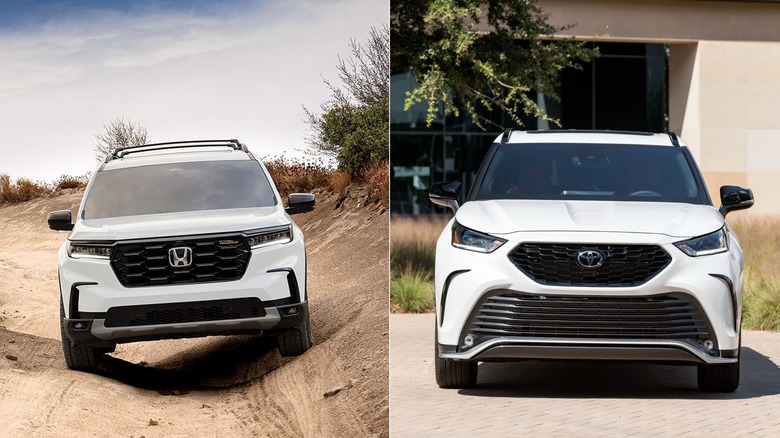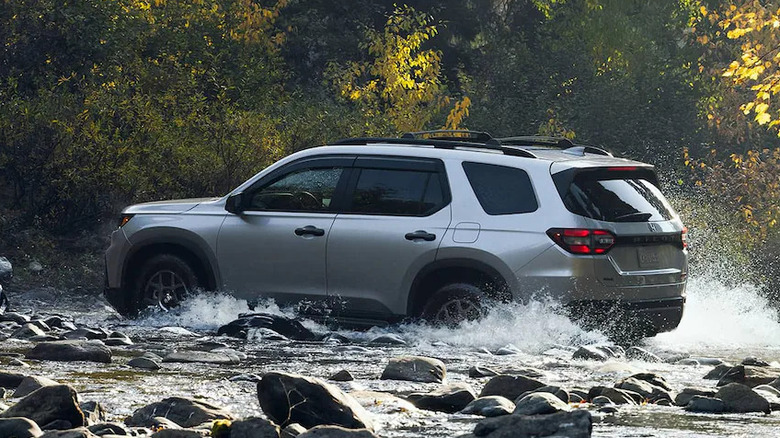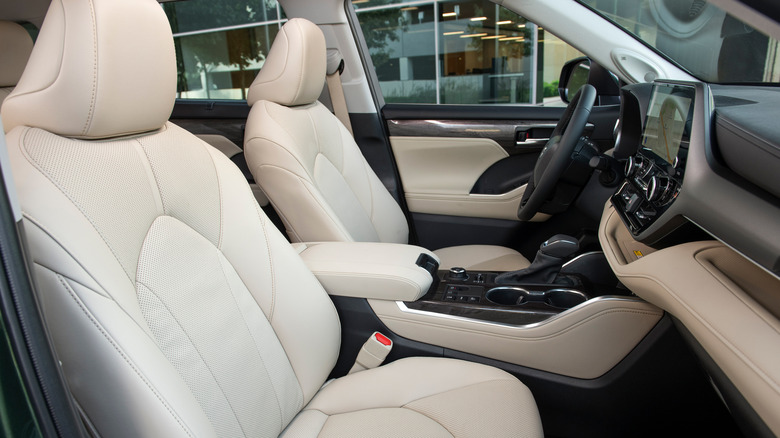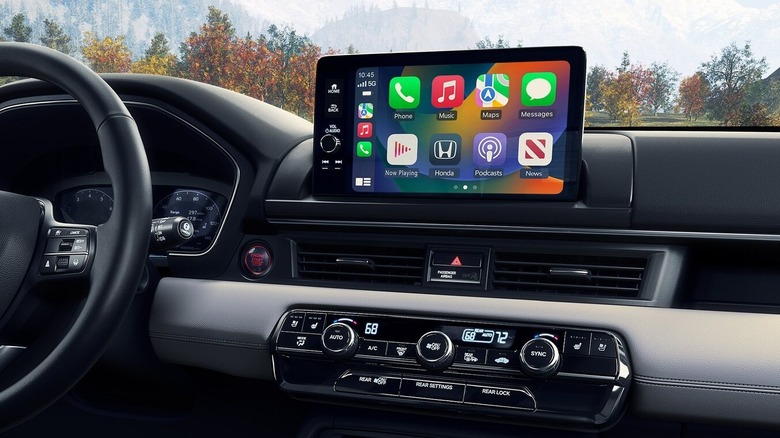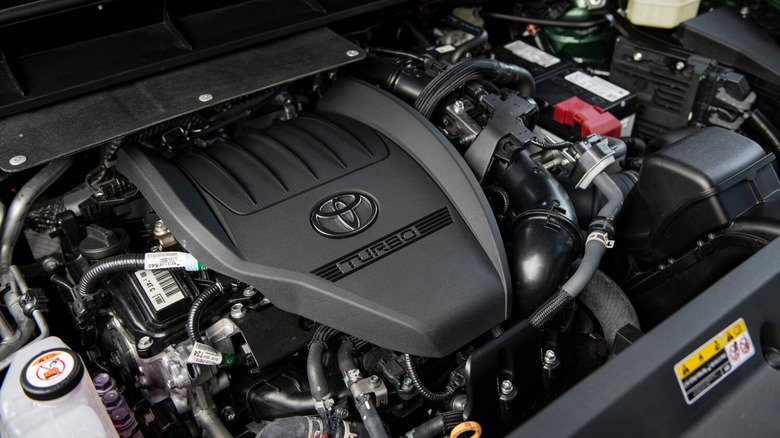Honda Pilot Vs. Toyota Highlander: How Do These Popular SUVs Compare?
Two of the most ubiquitous crossover SUVs on the road have long been the Honda Pilot and the Toyota Highlander. Highlander strode onto the market in 2001, and the Pilot was introduced in model year 2003.
As of 2023, they both continued to be strong sellers — top 10, even. Toyota sold 171,289 Highlanders in 2023 and Honda sold 110,298 Pilots. J.D. Power ranked the Pilot that year as the No. 2 Best Upper Midsize SUV, based on a consumer satisfaction score of 84/100. The same year, the Highlander scored an 80.
What makes these crossovers so popular? They have seized on a successful formula. Both Toyota and Honda were early adopters of unibody construction for an SUV and both crossovers are midsized. Together, they offer a better ride and car-like handling than large, truck-based SUVs typically do. They're easier to park and more flexible for both city and rural driving, giving them nearly universal appeal. They even fit three rows of seating in a midsized package.
Now in their fourth generation, each vehicle has splashed out for a new edition for 2025: Honda's Black Edition of the Pilot and Toyota's Limited 25th edition of the Highlander -– one of the coolest special editions Toyota has built.
Overall, the Pilot offers six models in 2025, which were introduced in March of this year and have a starting MSRP of $40,200 for the base trim Sport. The 2025 Highlander offers 10 models — five of which are hybrids and five are gas-powered SUVs. The MSRP for the base gas model (the LE) starts at $39,520.
Toyota says the 2025 lineup should reach U.S. Toyota dealerships in November 2024. Let's look at some of the things that differentiate these two favorite SUVs.
Exterior features to amaze your friends
Despite having many things in common — even looks to some extent — Honda has veered more in the direction of a sporting utility while Highlander pursues a refined, city version of SUVing. Only Honda offers a trim that is marketed as off-road capable. The TrailSport boasts higher ground clearance, off-road tuned suspension, steel skid plates underneath (in case drivers misgauge ground clearance), and all-terrain tires as standard equipment. Even non-TrailSport Pilots have cladding on lower panels and around wheel wells, giving them a trail-ready look, which the Highlander imitates demurely with its own cladded wheel wells. Both Pilot and Highlander offer terrain selection drive modes (mud, snow, and sand) in their AWD trims, so both can safely get drivers across at least uneven or challenging road surfaces with peace of mind.
To keep up with the luxury models in the segment, Toyota introduced a Highlander Limited 25th Edition, touting refinements such as carpet floor mats, a key glove, illuminated door sills, and puddle lamps. Honda's new Black Edition features fancy exterior modifications and upscale interiors for $14,380 more than the base Sport model costs, and seems in answer to Toyota's Nightshade editions. The Black Edition perches atop the Pilot lineup on 20-inch, gloss-black alloy wheels. Exterior blackouts include grille bar, front fascia ducts, door and rear bumper garnishes, and logo badging and embossing, outside and in. Interior red accents, red ambient lighting, and leather seating make this edition stand out. The price includes the Intelligent Variable Torque Management all-wheel-drive system as standard.
Interior features for crew and cargo
These crossovers are classed as midsize and seat up to eight for models with bench seating in the second row. The XLE and better trims of the Highlander, the Pilot TrailSport, and optionally the EX-L trim, have captain's chairs in the second row, so they seat seven. Seats are either leather-trimmed or one of several synthetic upholsteries, depending on the model.
The Pilot is the slightly bigger vehicle, coming in at three or more inches larger in all dimensions – length, width, and height. This gives the Honda 158 cubic feet of passenger volume to Toyota's 142 cubic feet. That generally translates into the Honda supplying passengers with an inch or more of room in each dimension, expanding the second and third row seating even more generously.
Cargo space is similarly sized for the Pilot as for the Highlander. However, the larger Pilot again has the edge: 87 cubic feet when the back two rows are folded down; the Highlander can hold 84 cubic feet of cargo when its second and third row are folded down.
Technology for fun and safety
Honda makes it easy to pair smartphones with the Pilot's wireless Apple CarPlay and Android Auto feature. It lets you send and receive texts, access your music library, and navigate. A 7.0-inch infotainment touchscreen or 9.0-inch display provide access to subscription entertainment such as SiriusXM and HD Radio. This vehicle also offers a CabinTalk In-Car PA System (through speakers) – undoubtedly invented after a noisy family road trip.
Highlander offers Apple CarPlay and Android Auto, subscriptions to SiriusXM, and a multimedia display of up to 12.3 inches for navigation and entertainment controls. Toyota's suite of connected services can do things like link a smartwatch or phone to the SUV (Remote Connect) or turn the Highlander into a hot spot (Wi-Fi Connect).
Both ICE (internal combustion engine) and hybrid Highlanders scored well in NHTSA crash tests, with a 5-star overall rating. To help prevent Highlanders from crashing, they are packed with standard safety features. Many of these standard safety features are also found on the Pilot, including lane-departure warning with lane-keeping assist, traffic sign recognition, adaptive cruise control, automated emergency braking with pedestrian detection, automatic high-beam headlamps, and blind-spot monitoring with rear-cross-traffic alert.
In NHTSA testing, the Pilot rated an impressive five stars in overall safety for both FWD and AWD models. Additional safety features on the Pilot TrailSport edition include Trail mode, which optimizes the powertrain for low-speed crawls when the terrain is extra unforgiving. Its TrailWatch feature displays a live feed from around the SUV to aid in traveling off-road.
Comparing powertrains
Where the two vehicles really diverge is in their powertrain options. The Honda Pilot is only offered with a gas engine. Each Pilot has a 3.5L V6 that delivers 285 horsepower and 262 lb-ft of torque. The transmission is a 10-speed shiftable automatic.
The Highlander is available with a gas engine or as a hybrid. The ICE version has a 2.4L 4-cylinder turbo engine with stop-start technology and a Direct shift 8-speed electronically controlled automatic transmission (ECT). It makes 265 horsepower, with 310 lb-ft of torque.
Toyota introduced its first hybrid Highlander for the 2006 model year, making it Toyota's first hybrid-powered SUV. The current hybrid powertrain is a 2.5-liter L4HV that makes 186 hp with 175 lb-ft of torque. Combined with the three permanent magnet synchronous motors (two in the front, one in the back), the AWD hybrid offers up 243 net horsepower. The transmission is an electronically controlled continuously variable transmission (ECVT).
Each automaker offers two-wheel and all-wheel drive models. Honda's 2WD is rated at 19/27 city/highway gas mileage, and the AWDs are rated 19/25 city/highway — except for the AWD TrailSport, whose steel skid plates and hefty tires probably helped knock mileage down a little to 18/23 city/highway.
The gas Highlander has an estimated mpg of up to 22/29 city/highway for front-wheel drive and 21/28 city/highway for AWD. The hybrid models are rated around 35 mpg.
